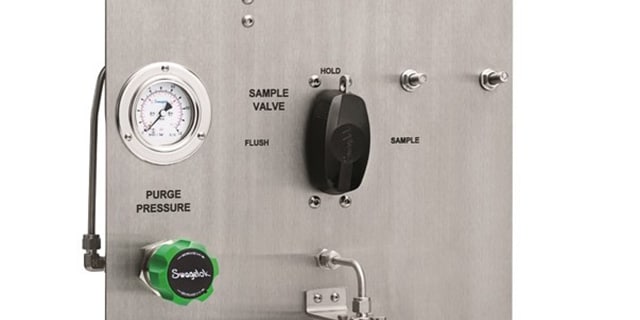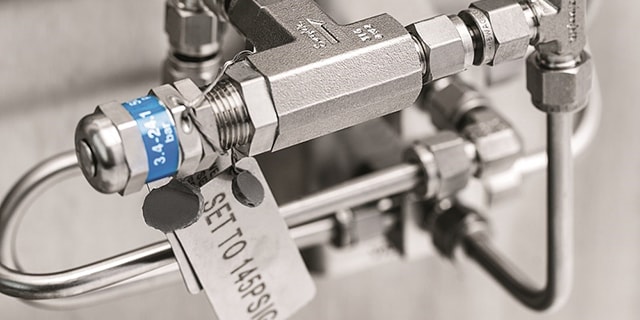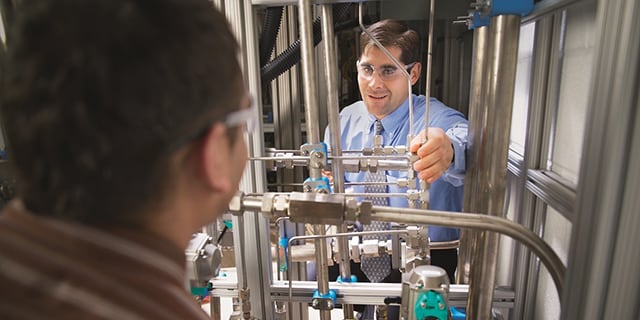How to Fix Common Grab Sampling Deficiencies

How to Fix Common Grab Sampling Deficiencies

Grab sampling is a critical function in many industrial fluid systems and building best practices with respect to the sampling process helps operators achieve quality results in a safe environment.
Good representative samples validate process conditions, validate the online analyzer and ensure end products meet the required quality specifications, helping operators meet the needs of their customers. Safety is critical here, too. Following the right sampling procedures, using the right equipment, and having a safe system design help reduce the risk of a potentially dangerous situation, especially where process liquids and gases are toxic or flammable.
The Swagelok Field Engineering Team inspects a variety of liquid and gas grab sampling systems and setups while working in the field, all over the world. Many are optimized and operate properly, but many are not. It is our goal to help customers assess grab sampling design and performance, especially in high-risk systems. We help identify improvement opportunities, whether via new components or a new grab sample system design, recommended best practices, and more.
Over the years, patterns have emerged, and some of the most common problems our team sees can be the most easily fixed. Sometimes, these fixes require new equipment or component considerations. Sometimes, it is a change to practices and procedures to ensure safe handling and transport of sampling. No matter the nature of these fixes, each can ensure that operators and technicians are obtaining good samples safely and consistently for the betterment of your entire operation.
Sample identification.
First, the correct identification of specific grab sampling points throughout a fluid system is important. It is a common practice for plants to specifically tag equipment like vessels, pumps, control valves, heat exchangers, and more. Grab sampling locations are no different.
The issue: Sample points should be named and labeled with specificity, but that is not always something we see in the field. For example, sometimes grab sampling points are listed as simply a “sample point” and can only be correctly identified through operator knowledge. In this instance, there is no method of correctly verifying each sample point without referring to system schematics and tracing the pipework to the nearest process equipment to which it is attached. This type of nonspecific labeling can lead to intermixing of different samples when containers (cylinders) are not dedicated to a specific sample system and can lead to unsafe situations when containers do not comply with the process condition.

The fix: As a best practice, operators should develop a naming convention for grab sample points for easy and specific identification. An asset register should correlate with each sample point, including information like:
- Location of sample points.
- Fluid being sampled, its composition, fluid state.
- Pressure and temperature.
- Potential hazards.
- Container type.
- Critical spares and part numbers.
- Frequency of sampling.
- Flush time for representative sampling.
Efficient, quality sampling.
The importance of sample quality is worth reiterating, and there are a few strategies and design best practices that can be incorporated into grab sampling systems that help ensure sample quality, representativeness, and consistency.
The issue: It is not uncommon for our teams to observe grab sample points where samples are drawn directly from a nozzle. This can lead to a few issues or inefficiencies and potential quality compromises. In gas samples, for example, additional volume contained within the nozzle means a delayed sample

filter samples for more
accurate analysis.
The fix: The use of a probe for sampling purposes can eliminate each of these inefficiencies in a variety of process applications. Probes avoid particles and eliminate additional volume. They also make certain the samples are drawn from one-third of the inner process pipe wall to the center of the process line, providing greater accuracy and representativeness. To reduce sample response time, the gas pressure should be reduced right after the process interface valve to reduce compressed gas volume. This method reduces risks of transporting high-pressure gas through the plant as well.
As long as there is a suitable end connection, sample probes can be installed into existing sample supply nozzles in most process lines. Ideally, probes should be installed in a lower part of a vertical process line for liquid sampling to ensure gas in lines with a liquid will likely not travel down the probe. For gas sampling, probes should be installed on top of a horizontal pipe. Probes should never be installed on a bend to avoid sampling a separated sample or off the bottom of a pipe to avoid contamination like particles, and condensate in gas lines will travel down the probe into the transport line.
Safe, accurate sample handling.
Extraction and handling are critically important factors for maintaining a representative sample once it has been drawn off the process. There are several variables that must be accounted for.
The issue: There are a few sample collection and handling deficiencies that our team observes with some frequency. For example, we have observed high-pressure liquid grab sampling practices that lead to spillovers and splashing of the product. Not only can this be wasteful, but also potentially dangerous for the sampling technician and could be in violation of environmental regulations. Additionally, it is not uncommon that we see technicians placing a captured liquid sample into an open bottle for transport back to the lab. However, because the light components will evaporate or fractionate above their dew point if not maintained under the right pressure and temperature, open bottles will inevitably lead to sample inaccuracy. Again, there is some potential danger to open sampling, which can expose technicians to toxic samples and fumes.

The fix: Fixed-volume liquid sampling can reliably eliminate these risk factors. They are particularly beneficial in high-pressure applications and help ensure repeatable, accurate sample volumes. Fixed-volume sampling can also be calibrated to leave 20% of the volume in the container free, allowing for thermal expansion of liquid.
Logical sampling locations.
Finally, we should take operational efficiency into consideration. Are your grab sampling methods prohibitive to driving new efficiencies on your plant? Are sampling stations placed in the most convenient location for your teams?
The issue: With some frequency, Swagelok teams come across sample systems in unoptimized locations. One common example is when the sampling system is located over a control valve. When the control valve is closed, this cuts off flow to the system, leading to compromised and unrepresentative samples. Where a control valve is fully open, there will be no pressure drop, leading to the flow to the sample system is unknown or even not flowing at all.

The fix: Sample points should generally be positioned over a pump, before and after a process stream, or in end-product lines. This enables operators to efficiently draw reliable samples without needing to worry about shut-off or valves or control valve position. The convenience of sampling locations should also be considered in total system design, allowing easy access to sampling points. Additionally, the consolidation of individual sample points where possible can help reduce risk of error from taking a sample from the wrong point and can help lead to significant cost savings.
Interested in learning more about how your plant could benefit from optimizing its grab sampling practices? Explore how Swagelok’s Evaluation and Advisory Services can help.
Related Articles

Grab Sampling 101: Reducing Plant Costs
Grab sample systems allow for safe, efficient sample captures—validating your product’s chemical composition. Learn how to improve your closed loop system’s reliability while reducing plant costs with basics from the experts at Swagelok.

Why Haven’t Sampling Systems Improved — Three Main Reasons
The past 50 years, process analyzers have vastly improved— but sampling systems have not. Luckily, most issues are due to human error & can be corrected with proper training. Learn three reasons why sampling systems fail & solutions for your plant.

10 Tips to Improve Sampling Systems
Managing an analytical instrumentation operation is no small feat. Receiving consistent results can be a struggle for even the most seasoned engineers. Luckily, there are several simple tips your team can use to improve your sampling system.

